Themed collection Celebrating ten years of Journal of Materials Chemistry C

Introducing the tenth anniversary issues of Journal of Materials Chemistry A, B and C
Past and present Editors-in-Chief and Editorial Board Chairs introduce the 10th anniversary issues of Journal of Materials Chemistry A, B and C, reflecting on the rich history of the journals and looking ahead to the exciting future of materials chemistry.

J. Mater. Chem. C, 2023,11, 7858-7859
https://doi.org/10.1039/D3TC90065G
Interface engineering of perovskite nanocrystals: challenges and opportunities for biological imaging and detection
This perspective discusses the recent progress and efforts on the interface engineering of water-resistant perovskite nanocrystals as fluorescent probes for biological diagnosis.
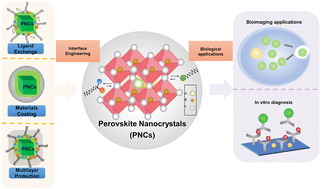
J. Mater. Chem. C, 2023,11, 7970-7981
https://doi.org/10.1039/D2TC04967H
Biogenic amine sensors using organic π-conjugated materials as active sensing components and their commercialization potential
This paper highlights the use of conjugated organic materials to construct sensors for the detection of biogenic amines released from decomposing food stuffs.

J. Mater. Chem. C, 2023,11, 9749-9767
https://doi.org/10.1039/D3TC00383C
Carbon-centered radical based dynamic covalent chemistry for stimuli-responsive chromic materials
Stimuli-responsive chromic materials have received increasing research attention. This review summarizes the most cutting-edge carbon-centered radicals, with a focus on their structures, properties and applications as stimuli-chromic materials.

J. Mater. Chem. C, 2023,11, 7957-7969
https://doi.org/10.1039/D3TC00117B
Self-powered ionic tactile sensors
Tremendous efforts have been devoted to wearable mechanical sensors to meet growing needs in healthcare sensors and electronic skins.

J. Mater. Chem. C, 2023,11, 7920-7936
https://doi.org/10.1039/D2TC05109E
Optoelectronic materials utilizing hot excitons or hot carriers: from mechanism to applications
Traditionally, hot excitons or hot carriers generated in semiconductors were considered unfavourable for many applications, given that they may cause energy loss and device degradation.

J. Mater. Chem. C, 2023,11, 7937-7956
https://doi.org/10.1039/D3TC00009E
Phthalocyanines, porphyrins and other porphyrinoids as components of perovskite solar cells
This review highlights the most relevant works on phthalocyanines, porphyrins and other porphyrinoids as components of perovskite solar cells from the last four years acting as hole transporting materials, additives, and interlayers.
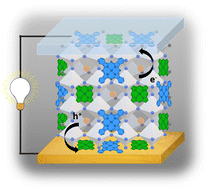
J. Mater. Chem. C, 2023,11, 7885-7919
https://doi.org/10.1039/D2TC04441B
Preserving the shape of silver nanocrystals
Preserve the shape of silver nanocrystals by decorating a shell or frame composed of a more corrosive resistant metal on their surfaces for applications in plasmonics, catalysis, and electronics.

J. Mater. Chem. C, 2023,11, 7872-7884
https://doi.org/10.1039/D2TC05105B
Infrared emitting and absorbing conjugated polymer nanoparticles as biological imaging probes
We discuss the synthesis of infrared-emitting conjugated polymer nanoparticles and their use in biological imaging. The image shows the vasculature of a mouse brain imaged with conjugated polymer nanoparticles (M. Liu et al., Angew. Chem., Int. Ed., 2021, 60, 983–989).
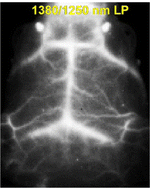
J. Mater. Chem. C, 2023,11, 7860-7871
https://doi.org/10.1039/D2TC02042D
Porous film impregnation method for record-efficiency visible-to-UV photon upconversion and subsolar light harvesting
A record-high visible-to-ultraviolet (UV) upconversion efficiency of 27.6% for films is achieved by a simple method using porous film. Subsolar visible light is successfully converted to UV light by integrating the film with a microlens array.
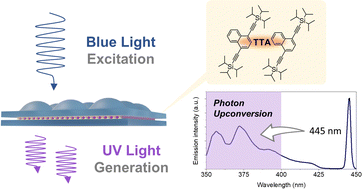
J. Mater. Chem. C, 2023,11, 8002-8006
https://doi.org/10.1039/D3TC00236E
Theoretical investigation of the non-metal sites of two-dimensional conjugated metal–organic frameworks based on benzenehexathiol for hydrogen evolution activity enhancement
Interlayer interactions are proved to be essential in determining the accurate active site of metal–benzenehexathiol (M–BHT) for hydrogen evolution and Mo–BHT is predicted to be a new promising member of the family of highly active M–BHT catalysts.
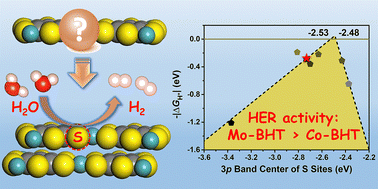
J. Mater. Chem. C, 2023,11, 7989-7994
https://doi.org/10.1039/D3TC00238A
A photo-responsive organic electrochemical transistor
OECTs capable of undergoing a reversible modulation of ON current by up to 30% via irradiation with UV and visible light were realised via blending of a mixed ionic–electronic polymer (pgBTTT) and a photoswitching spiropyran derivative (OEG-SP).

J. Mater. Chem. C, 2023,11, 7982-7988
https://doi.org/10.1039/D2TC05444B
Mechanophotonics: fabrication of a 2 × 2 hybrid directional coupler from flexible organic crystals
A miniature, multifunctional hybrid organic directional coupler (HDC), constructed from two different flexible organic crystals, splits the optical signal and delivers input-dependent optical outputs.

J. Mater. Chem. C, 2023,11, 7995-8001
https://doi.org/10.1039/D2TC05044G
Mission immiscible: overcoming the miscibility limit of semiconducting:ferroelectric polymer blends via vitrification
Morphological diversity, phase separated to highly intermixed, is induced in low miscibility blends via solution vitrification through control of liquid state chain entanglements, enabling establishment of relevant structure/property relations and a diverse property set.

J. Mater. Chem. C, 2023,11, 8300-8306
https://doi.org/10.1039/D3TC00071K
A marvel of chiral squaraine aggregates: chiroptical spectra beyond the exciton model
An extensive experimental study of a family of chiral aggregates of proline derived squaraines is presented and discussed with reference to two theoretical models and to MD simulations to shed light on the chiroptical properties of these systems.
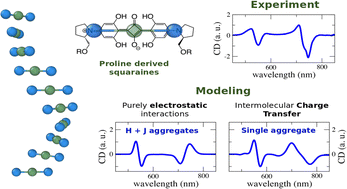
J. Mater. Chem. C, 2023,11, 8307-8321
https://doi.org/10.1039/D2TC05555D
On the factors affecting the response time of synaptic ion-gated transistors
Response time and plasticity of P3HT-IGTs can be controlled by engineering input stimuli. IGTs can be employed as neuromorphic devices integrating memory (LTP) and processing functions (STP) in the same device, as a function of biasing conditions.

J. Mater. Chem. C, 2023,11, 8293-8299
https://doi.org/10.1039/D3TC00161J
Color tuning of multi-resonant thermally activated delayed fluorescence emitters based on fully fused polycyclic amine/carbonyl frameworks
Two newly developed carboynyl-based multi-resonant TADF show bright green-yellow emission. These were used as emitters in both OLEDs, and LECs.

J. Mater. Chem. C, 2023,11, 8263-8273
https://doi.org/10.1039/D3TC00641G
Electrical properties of amorphous Zn–Sn–O thin films depending on composition and post-deposition annealing temperature near crystallization temperature
This study investigated the crystallization and electrical properties of atomic layer deposited Zn–Sn–O (ZTO) thin films. Sn 42 at% ZTO thin film showed the best thermal stability and electrical properties due to a change in the sub-gap states.

J. Mater. Chem. C, 2023,11, 8254-8262
https://doi.org/10.1039/D2TC05090K
Molecular geometry and the photophysics of thermally activated delayed fluorescence: the strange case of DMAC-py-TRZ
We present the synthesis, optoelectronic characterization, and a detailed theoretical study of DMAC-py-TRZ, a novel, efficient TADF emitter.

J. Mater. Chem. C, 2023,11, 8284-8292
https://doi.org/10.1039/D2TC05213J
Side-chain engineering of self-doped conjugated polyelectrolytes for organic electrochemical transistors
Varied-length conjugated polyelectrolytes (2–5 methylene units) containing CPDT-alt-BT were synthesized to study the optical, electrochemical, and morphological properties. These were used in accumulation mode organic electrochemical transistors.

J. Mater. Chem. C, 2023,11, 8274-8283
https://doi.org/10.1039/D3TC00355H
Fluorinated- and non-fluorinated-diarylamine-Zn(II) and Cu(II) phthalocyanines as symmetrical vs. asymmetrical hole selective materials
Four symmetrically substituted and four asymmetrically substituted fluorinated and non-fluorinated-diarylamine CuPcs and ZnPcs have been designed and utilized as hole transporting materials in perovskite solar cells.

J. Mater. Chem. C, 2023,11, 8243-8253
https://doi.org/10.1039/D3TC00254C
Organic copolymer lasing from single defect microcavity fabricated using laser patterning
This study uses a laser patterning setup to write defect structures into a conjugated polymer microcavity. We show that the defect enhances optical confinement and reduces the lasing threshold.

J. Mater. Chem. C, 2023,11, 8204-8213
https://doi.org/10.1039/D2TC05360H
A low-symmetry monothiatruxene-based hole transport material for planar n–i–p perovskite solar cells with 18.9% efficiency
Asymmetric truxene-based hole-transport material shows stable amorphous film and good efficiency in perovskite solar cell.

J. Mater. Chem. C, 2023,11, 8214-8222
https://doi.org/10.1039/D3TC00119A
Influence of alkyl chain length on the photovoltaic properties of dithienopyran-based hole-transporting materials for perovskite solar cells
A tailored design of asymmetric hole-transporting materials (HTMs) is reported with the synthesis of a family of new HTMs based on the use of the 5H-dithieno[3,2-b:2′,3′-d]pyran (DTP) moiety endowed with donor p-methoxytriphenylamines.

J. Mater. Chem. C, 2023,11, 8223-8230
https://doi.org/10.1039/D2TC05468J
Photostability of amine-free CsPbBr3 perovskite nanocrystals under continuous UV illumination
In this work, we verified that light induces a dynamic equilibrium between ligands and the inorganic surface in amine-free perovskite nanocrystals, and we demonstrated that oleylphosphate ligands can improve the photostability of cesium lead bromide perovskite nanocrystals.
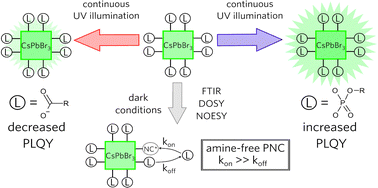
J. Mater. Chem. C, 2023,11, 8231-8242
https://doi.org/10.1039/D2TC04953H
Rational design of hybridized local and charge transfer emitters towards high-performance fluorescent blue OLEDs
We present two HLCT blue emitters by grafting anthracene in the D–A segment. The blue OLEDs exhibit a good performance with an EQEmax up to 5.53%. It is revealed that hRISC from T2 to S1 serves as an efficient approach to harvest the triplet exciton.
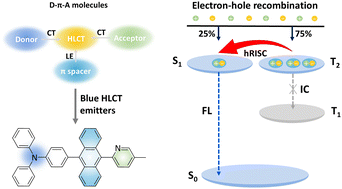
J. Mater. Chem. C, 2023,11, 8196-8203
https://doi.org/10.1039/D2TC05554F
Nitrofluorene-based A–D–A electron acceptors for organic photovoltaics
We explored nitrofluorene derivatives as tunable electron-withdrawing groups for acceptor–donor–acceptor (A–D–A) type non-fullerene acceptors.

J. Mater. Chem. C, 2023,11, 8186-8195
https://doi.org/10.1039/D2TC05127C
Remarkable performance recovery in highly defective perovskite solar cells by photo-oxidation
Exposure to oxygen and light leads to a remarkable performance improvement in the case of highly-defective metal halide perovskite solar cells.
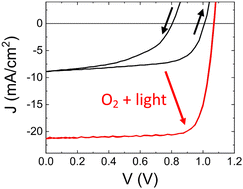
J. Mater. Chem. C, 2023,11, 8007-8017
https://doi.org/10.1039/D2TC05077C
Air-stable ternary organic solar cells achieved by using fullerene additives in non-fullerene acceptor-polymer donor blends
Addition of a fullerene derivative to a PBTATBT-4F:Y6 blend significantly enhances cell stability, which retained 90% of the initial PCEs (13–14%) even after storage in air for 6 months, compared to only 20% retention for the binary device.
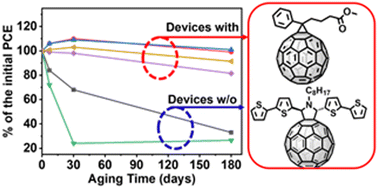
J. Mater. Chem. C, 2023,11, 8074-8083
https://doi.org/10.1039/D2TC04971F
Star-shape non-fullerene acceptor featuring an aza-triangulene core for organic solar cells
A novel star-shape non-fullerene acceptor containing an aza-triangulene core is synthesized, characterized and used in inverted organic solar cells.

J. Mater. Chem. C, 2023,11, 8161-8169
https://doi.org/10.1039/D2TC05424H
Simulation of polymeric mixed ionic and electronic conductors with a combined classical and quantum mechanical model
We present a model enabling the simulation of doped polymers in the vicinity of water and ions taking into account large electronic rearrangements coupled with slow dynamics.
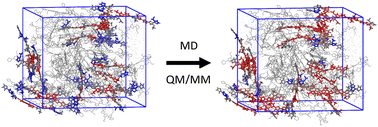
J. Mater. Chem. C, 2023,11, 8062-8073
https://doi.org/10.1039/D2TC05103F
Binder polymer influence on the electrical and UV response of organic field-effect transistors
Organic field-effect transistors (OFETs) and phototransistors using blends of Ph-BTBT-10 with binding polymers are prepared. We show that tuning the nature of the polymer is a useful tool to optimise the OFET performance and photoresponsivity.
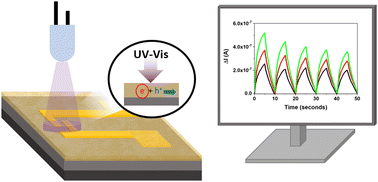
J. Mater. Chem. C, 2023,11, 8178-8185
https://doi.org/10.1039/D2TC05066H
A tetrathiafulvalene salt of the nitrite (NO2−) anion: investigations of the spin-Peierls phase
The first nitrite salt of a tetrathiafulvalene derivative exhibits a rare chessboard-like organization of the conducting stacks, with a spin-Peierls transition at 70 K.

J. Mater. Chem. C, 2023,11, 8170-8177
https://doi.org/10.1039/D2TC05431K
The fluorination effect: the importance of backbone planarity in achieving high performance ambipolar field effect transistors
Understanding the strategy of fluorination to control π-conjugation and intra and interchain interactions for the rational design of improved semiconducting polymers.

J. Mater. Chem. C, 2023,11, 8027-8036
https://doi.org/10.1039/D2TC05073K
Impact of two diammonium cations on the structure and photophysics of layered Sn-based perovskites
Layered metal-halide perovskites have shown great promise for applications in optoelectronic devices, where a large number of suitable organic cations give the opportunity to tune their structural and optical properties.

J. Mater. Chem. C, 2023,11, 8154-8160
https://doi.org/10.1039/D2TC04626A
Organic ammonium iodide salts as passivation for buried interface enables efficient and stable NiOx based p-i-n perovskite solar cells
The interfaces between a halide perovskite absorber film and its charge transporting layers have been identified as one of the key bottlenecks for achieving high performance and stability.

J. Mater. Chem. C, 2023,11, 8146-8153
https://doi.org/10.1039/D2TC04215K
Atomic layer deposition of HfNx films and improving the film performance by annealing under NH3 atmosphere
Flowchart illustrating how the films are deposited (a) without and (b) with cleaning step, and Auger electron spectroscopy depth profile of 15 nm HfNx deposited with precleaning step, before annealing (c) and after 900 °C annealing at NH3 atmosphere.

J. Mater. Chem. C, 2023,11, 8018-8026
https://doi.org/10.1039/D2TC03964H
High-performance semitransparent organic solar cells based on sequentially processed heterojunction
Semitransparent organic solar cells based on sequentially processed heterojunction (SHJ) structure show a power conversion efficiency (PCE) of 12.5% and an average visible transmittance (AVT) of 25.4%, outperforming the BHJ counterpart (PCE = 11.8%, AVT = 22.9%).

J. Mater. Chem. C, 2023,11, 8121-8128
https://doi.org/10.1039/D2TC04507A
Thermal quenching of lanthanide luminescence via charge transfer states in inorganic materials
The thermal quenching data of 5d emission from Eu2+ and Ce3+ and 4f emission from Pr3+, Eu3+, and Tb3+ are shown to be consistent with vacuum referred binding energy schemes. The scheme construction parameters of 170 different compounds are provided.

J. Mater. Chem. C, 2023,11, 8129-8145
https://doi.org/10.1039/D2TC04439K
Sublimable complexes with spin switching: chemical design, processing as thin films and integration in graphene-based devices
Chemical design of complexes with thermal- and light-induced spin switching and integration as thin films in graphene-based devices by sublimation.
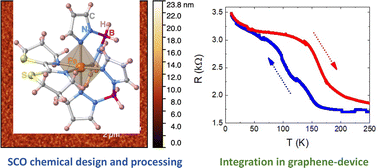
J. Mater. Chem. C, 2023,11, 8107-8120
https://doi.org/10.1039/D2TC04120K
Shape programming and photoactuation of interpenetrating polymer networks containing azobenzene moieties
The shape memory effects and photoinduced deformation behaviour of interpenetrating polymer network (IPN) films containing azobenzene liquid-crystalline polymers were investigated.

J. Mater. Chem. C, 2023,11, 8100-8106
https://doi.org/10.1039/D2TC04067K
Impact of oxidation-induced ordering on the electrical and mechanical properties of a polythiophene co-processed with bistriflimidic acid
The interplay between the nanostructure of a doped polythiophene with oligoether side chains and its electrical as well as mechanical properties is investigated.

J. Mater. Chem. C, 2023,11, 8091-8099
https://doi.org/10.1039/D2TC03927C
Mn2+-doped Cs2ZnBr4 scintillator for X-ray imaging
Cs2ZnBr4:Mn2+ and its composite film demonstrate good X-ray scintillation performances with a spatial resolution of 5.06 lp mm−1 in X-ray imaging.

J. Mater. Chem. C, 2023,11, 8052-8061
https://doi.org/10.1039/D2TC04249E
Bio-inspired micro area concentrated array assisted perovskite photodetector toward weak light imaging
A perovskite photodetector with bio-inspired micro area concentrated structures has been fabricated for weak light imaging. The photodetector exhibits high detectivity (1.37 × 1013 Jones), and it can achieve weak light imaging under 0.64 μW cm−2.
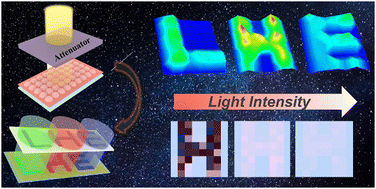
J. Mater. Chem. C, 2023,11, 8045-8051
https://doi.org/10.1039/D2TC03760B
Fine-tuning emission properties of the 9H-phenoselenazine core through substituents engineering for high efficiency purely organic room temperature phosphorescence
A high external quantum efficiency of 12.8% was achieved in the Se based organic emitter based device by substituent engineering on the pure organic room temperature phosphorescent core.

J. Mater. Chem. C, 2023,11, 8084-8090
https://doi.org/10.1039/D2TC03253H
Aggregation effects on the one- and two-photon excited fluorescence performance of regioisomeric anthraquinone-substituted perylenediimide
The isomerism effect on the aggregate emission properties of perylene diimide derivatives is studied. Banking on their bright emission, a cellular imaging test based on their nanoparticles is also conducted.

J. Mater. Chem. C, 2023,11, 8037-8044
https://doi.org/10.1039/D2TC03928A
About this collection
We are delighted to celebrate Journal of Materials Chemistry C’s tenth anniversary in 2023!
This special issue celebrates and thanks members of our community who have supported the journal over the last ten years, and we are honoured that these authors have shared their latest discoveries with us.
Ten years ago, with the launch of the three separate titles, the vision of Journal of Materials Chemistry A, B and C was to provide venues for highly topical research in a broad range of materials chemistry and this is exemplified in the three anniversary issues, which highlight diversity in its broadest sense, across the global materials chemistry community and covering the full breadth of our discipline.
We believe that Journal of Materials Chemistry A, B and C will continue to be the home of innovative, and impactful materials chemistry research for many years to come and hope you enjoy reading the diverse range of papers featured in the anniversary issues.
Journal of Materials Chemistry A anniversary issue
Journal of Materials Chemistry B anniversary issue